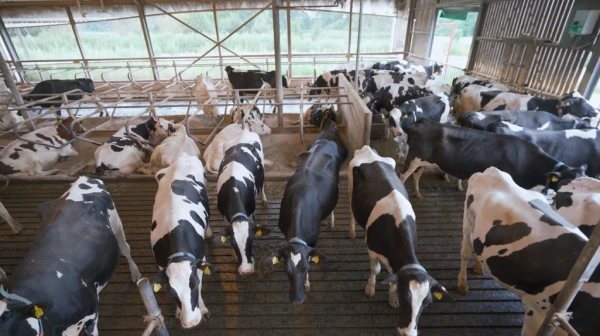
Reducing Greenhouse Gas and Ammonia Emissions from Cattle Housing

Europe
All
Benefits of the practice
- Emission mitigation
- Increased animal welfare
- Increased resilience to extreme weather conditions (e.g. heatwaves)
Production system
Dairy and beef cattle
Thematic Area
Manure storage and spreading
Reducing emissions from barns is a key environmental and welfare goal. Cattle housings emit methane (CH₄), ammonia (NH₃), and nitrous oxide (N₂O), in large part due to manure. NH₃ volatilizes easily due to soluble N and pH > 7.
Barn Emissions: Key Factors
⦁ Housing and Floors
⦁ In loose housing, bedding reduces NH₃ but may increase N₂O due to nitrification and denitrification
⦁ Solid and slatted floors have similar emissions; earthen floors have the highest N₂O emissions
⦁ Environment
⦁ On average, NH₃ rise by ~0.037 g/livestock unit/day for each +1°C temperature increase (See Çinar et al. (2023))
⦁ Farms in wet climates emit less NH₃ than those in dry climates
⦁ Diet
⦁ Overfeeding protein increases N excretion, mostly as urea, causing NH₃ and N₂O emissions. Dairy cattle generally emit more N₂O than beef cattle due to high N diet
⦁ Low starch increases N losses; balanced energy-protein ratios reduce emissions.
Recommendations for Farmers
⦁ Optimized Barns
⦁ Avoid earthen floors; solid/slatted floors are equally viable if kept sufficiently clean
⦁ Cubicles with frequent manure removal, minimizing the time the urease enzyme of the feces converts urine urea to NH₃, balance emissions and operations (see videos)
⦁ Use animal-friendly cleaning to increase cleaning and minimize injury
⦁ Minimize barn manure storage to lower CH4
⦁ Climate Control
⦁ Maintain good control over energy consumption (except for natural ventilation) to keep a low carbon footprint
⦁ Insulate roofs and provide shade to reduce heat in summer
⦁ Focus on NH₃ mitigation and N₂O reduction in dry and wet climates respectively
⦁ Adjust Diets
⦁ Reduce protein (CP) to 12–14% for dairy cattle and 10–12% for beef cattle, ensuring balanced energy and aminoacids
⦁ Adopt precision feeding to match CP intake to herd needs
⦁ Use high-quality forage and test feed regularly to ensure high N assimilation and digestibility, reducing N and CH₄ emissions
Federico Dragoni
